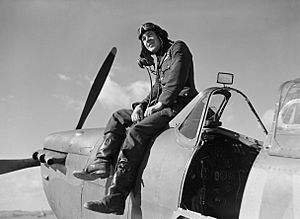Leonard Haines facts for kids
Quick facts for kids
Leonard Haines
|
|
|---|---|

Haines, September 1940
|
|
| Born | December 1919 Melcombe Regis, United Kingdom |
| Died | 30 April 1941 (aged 21) Hounslow Barracks, Middlesex, United Kingdom |
| Buried |
Hounslow Cemetery, United Kingdom
|
| Allegiance | United Kingdom |
| Service/ |
Royal Air Force |
| Years of service | 1937–1941 |
| Rank | Flying Officer |
| Unit | No. 19 Squadron |
| Battles/wars | Second World War |
| Awards | Distinguished Flying Cross |
Leonard Haines, DFC (born December 1919 – died 30 April 1941) was a brave flying ace who served in the Royal Air Force (RAF) during the Second World War. A "flying ace" is a pilot who has shot down five or more enemy aircraft. Leonard Haines was credited with destroying at least eight German planes during his time in the RAF.
Born in Melcombe Regis, England, Haines joined the RAF in 1937. After his training, he joined No. 19 Squadron. He achieved his first victory while protecting the beaches at Dunkirk during Operation Dynamo. His squadron also played a big part in the Battle of Britain, where Haines shot down many enemy aircraft. He received the Distinguished Flying Cross for his bravery. In late 1940, he became an instructor. Sadly, he died in a flying accident in April 1941, when he was just 21 years old.
Contents
Early Life and Joining the RAF
Leonard Archibald Haines was born in December 1919 in Melcombe Regis, United Kingdom. His parents were Archibald and Bertha Charles Haines. He went to Dorchester Grammar School and then to Queen Elizabeth Grammar School in Wimborne.
In September 1937, Leonard joined the Royal Air Force (RAF). He wanted to become a pilot. By November 1937, he was a pilot officer. He officially became a pilot officer in September 1938. After his training, he was sent to No. 19 Squadron.
Flying in World War II
No. 19 Squadron was based at Duxford. It was the very first RAF unit to fly the amazing Supermarine Spitfire fighter plane. When the Second World War began, the squadron mostly flew patrols to protect ships.
Leonard Haines was promoted to flying officer on 27 May 1940. Around this time, his squadron was busy protecting the skies over Dunkirk. This was during a huge event called Operation Dynamo.
Protecting Dunkirk
Operation Dynamo was when many Allied soldiers were evacuated from the beaches of Dunkirk. On 1 June, Haines shot down a German Messerschmitt Bf 109 fighter plane. This happened north-east of the evacuation beaches. He also believed he destroyed a Heinkel He 111 medium bomber in the same area.
The Battle of Britain
After their work at Dunkirk, No. 19 Squadron tested Spitfires with cannons. These cannons were not very reliable at first. This made it harder for the squadron during the early parts of the Battle of Britain.
On 19 August, Haines was flying a Spitfire with machine guns. He helped destroy a German Messerschmitt Bf 110 heavy fighter east of Aldeburgh. By September, the squadron was back to using standard machine guns. They flew regularly as part of the Duxford Wing, a group of squadrons working together.
On 3 September, Haines shot down a Bf 110 over the Thames Estuary. Two days later, he destroyed a Bf 109 near Chatham. He then destroyed another Bf 110 over Gravesend on 11 September.
A Hero's Recognition
On Battle of Britain Day, 15 September, Leonard Haines had an incredible day. He destroyed three German aircraft: two Bf 109s and one Bf 110.
On 18 September, Haines helped shoot down a Junkers Ju 88 medium bomber over the Thames Estuary. On the same day, he likely destroyed a Bf 109 near the Isle of Sheppey.
Because of his many successes, he was given the Distinguished Flying Cross in early October. This award is for bravery in air operations. The official announcement was made in The London Gazette. It said:
Flying Officer Haines has destroyed seven enemy aircraft, and assisted in the destruction of another. Twice he has pursued hostile aircraft to France and shot them down. He has shown the utmost courage, tenacity and devotion to duty.
By this time, the fighting was slowing down. But No. 19 Squadron still met the Luftwaffe (German air force) sometimes. On 5 November, Haines helped destroy a Bf 109 over Birchington. He also helped two other pilots shoot down a Bf 110 east of Harwich. At the end of November, he destroyed a Bf 109 near Ramsgate.
Final Days and Legacy
At the end of 1940, Haines was sent to No. 53 Operational Training Unit at Heston. Here, he became an instructor, teaching new pilots.
Sadly, Leonard Haines was killed on 30 April 1941. He was in a flying accident. The Miles Master trainer aircraft he was flying spun out of control. It crashed at Hounslow Barracks in Middlesex. The person flying with him also died.
Leonard Haines is buried at Hounslow Cemetery. At the time of his death, he was credited with shooting down twelve German aircraft. Four of these were shared victories with other pilots. He also probably destroyed two more. He was a true hero of the skies.

